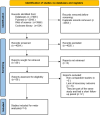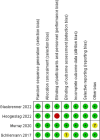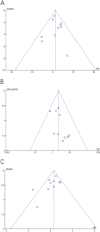ACL repair vs. reconstruction: a meta-analysis of outcomes across different tear characteristics
- PMID: 40764551
- PMCID: PMC12323060
- DOI: 10.1186/s12893-025-03101-6
ACL repair vs. reconstruction: a meta-analysis of outcomes across different tear characteristics
Abstract
Background: Anterior cruciate ligament (ACL) reconstruction remains the gold standard but carries donor-site morbidity and prolonged recovery. Modern ACL repair techniques theoretically preserve native proprioception and enable faster rehabilitation. We hypothesized that modern ACL repair would demonstrate non-inferior clinical outcomes compared to reconstruction.This meta-analysis compares clinical outcomes of primary repair versus autograft reconstruction.
Methods: We systematically searched PubMed, Cochrane Library, and Web of Science (2015–2025) for comparative studies (RCTs, cohorts, case-controls) reporting ≥ 2 key outcomes (failure rate, AP knee laxity, IKDC, Lysholm, or Tegner scores) with ≥ 1-year follow-up. Pooled ORs and WMDs with 95% CIs were calculated using RevMan 5.4. Subgroup analyses (injury-to-surgery time, injury location, study design, repair technique) and GRADE assessment were performed.
Results: Fourteen studies (4 RCTs, 8 cohorts, 2 case-controls; n = 908 patients) were included (repair: n = 460; reconstruction: n = 448). Failure/Revision Rates: Repair demonstrated numerically higher failure rates (OR = 2.24, 95% CI 1.30–3.86, P = 0.004) and revision rates (OR = 2.01, 95% CI 1.21–3.33, P = 0.007) versus reconstruction.Hardware removal: increased hardware removal incidence was observed in repair groups (OR = 8.19, 95% CI 2.89–23.20, P < 0.001).AP knee laxity: reconstruction showed marginally lower AP knee laxity (WMD = 0.30, 95% CI 0.06–0.53, P = 0.01).Patient-reported outcomes: no significant differences in IKDC (WMD = 1.31,95%CI: −0.01–2.63;P = 0.05) or Tegner scores (WMD: 0.01; 95% CI: -0.28– 0.30;P = 0.94). Lysholm scores slightly favored reconstruction (WMD = 1.62,; 95% CI: 0.35–2.89;P = 0.01).Key subgroup findings: repair achieved comparable outcomes to reconstruction in: (1) RCT-designed studies, (2) Acute repairs (< 21 days post-injury).
Conclusions: ACL repair is associated with higher failure and revision rates than reconstruction overall, but may be a viable alternative in selected patients with acute proximal tears.
Supplementary Information: The online version contains supplementary material available at 10.1186/s12893-025-03101-6.
Keywords: Acute proximal injury; Anterior cruciate ligament; Meta-analysis; Reconstruction; Repair.
Conflict of interest statement
Declarations. Ethics approval and consent to participate: not applicable. Consent for publication: not applicable. Competing interests: The authors declare no competing interests.
Figures








Similar articles
-
Role of tear location on outcomes of open primary repair of the anterior cruciate ligament: A systematic review of historical studies.Knee. 2017 Oct;24(5):898-908. doi: 10.1016/j.knee.2017.05.009. Epub 2017 Aug 10. Knee. 2017. PMID: 28803759
-
Acute anterior cruciate ligament rupture: can repair become an alternative to reconstruction: a meta-analysis of randomized controlled trials and cohort studies.J Orthop Surg Res. 2024 Jun 2;19(1):331. doi: 10.1186/s13018-024-04812-x. J Orthop Surg Res. 2024. PMID: 38825707 Free PMC article.
-
Combined Lateral Extra-Articular Tenodesis or Combined Anterolateral Ligament Reconstruction and Anterior Cruciate Ligament Reconstruction Improves Outcomes Compared to Isolated Reconstruction for Anterior Cruciate Ligament Tear: A Network Meta-analysis of Randomized Controlled Trials.Arthroscopy. 2023 Mar;39(3):758-776.e10. doi: 10.1016/j.arthro.2022.11.032. Epub 2022 Dec 8. Arthroscopy. 2023. PMID: 36567183
-
Repair versus reconstruction for proximal anterior cruciate ligament tears: a study protocol for a prospective multicenter randomized controlled trial.BMC Musculoskelet Disord. 2021 Apr 30;22(1):399. doi: 10.1186/s12891-021-04280-y. BMC Musculoskelet Disord. 2021. PMID: 33931067 Free PMC article.
-
Early Anterior Cruciate Ligament Treatment Might Be Crucial for Acute Combined Anterior Cruciate Ligament and Medial Collateral Ligament Injuries: A Systematic Review of the Various Treatment Strategies.Arthroscopy. 2024 Aug;40(8):2322-2336. doi: 10.1016/j.arthro.2024.01.009. Epub 2024 Jan 17. Arthroscopy. 2024. PMID: 38242254
References
-
- Sanders TL, Maradit Kremers H, Bryan AJ, et al. Incidence of anterior cruciate ligament tears and reconstruction: A 21-Year Population-Based study. Am J Sports Med. 2016;44(6):1502–7. 10.1177/0363546516629944. - PubMed
-
- Gee MSM, Peterson CDR, Zhou ML, Bottoni CR. Anterior cruciate ligament repair: historical perspective, indications, techniques, and outcomes. J Am Acad Orthop Surg. 2020;28(23):963–71. 10.5435/JAAOS-D-20-00077. - PubMed
-
- Sanders TL, Pareek A, Hewett TE, et al. Long-term rate of graft failure after ACL reconstruction: a geographic population cohort analysis. Knee Surg Sports Traumatol Arthrosc. 2017;25(1):222–8. 10.1007/s00167-016-4275-y. - PubMed
-
- Hughes JD, Lawton CD, Nawabi DH, Pearle AD, Musahl V. Anterior cruciate ligament repair: the current status. J Bone Joint Surg Am. 2020;102(21):1900–15. 10.2106/JBJS.20.00509. - PubMed
Grants and funding
- TSYC202301B077/the Natural Science Foundation of Xinjiang Uygur Autonomous Region
- TSYC202301B077/the Natural Science Foundation of Xinjiang Uygur Autonomous Region
- TSYC202301B077/the Natural Science Foundation of Xinjiang Uygur Autonomous Region
- TSYC202301B077/the Natural Science Foundation of Xinjiang Uygur Autonomous Region
- TSYC202301B077/the Natural Science Foundation of Xinjiang Uygur Autonomous Region
LinkOut - more resources
Full Text Sources

